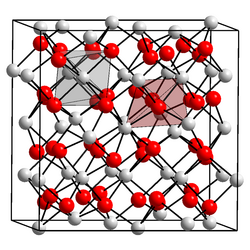 | |
| Names | |
|---|---|
| Other names diberkelium trioxide, berkelium sequioxide | |
| Identifiers | |
3D model (JSmol) | |
| |
| |
| Properties | |
| Bk2O3 | |
| Molar mass | 542 g·mol−1 |
| Appearance | yellow-green solid |
| Density | g/cm3 |
| Melting point | 1,920 °C (3,490 °F; 2,190 K) |
| insoluble | |
| Structure | |
| cubic | |
| Related compounds | |
Related compounds | Californium(III) oxide |
Except where otherwise noted, data are given for materials in their standard state (at 25 °C [77 °F], 100 kPa). | |
Berkelium(III) oxide is a binary inorganic compound of berkelium and oxygen with the chemical formula Bk
2O
3. [1]